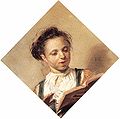
Malle Babbe is a painting by the Dutch Golden Age painter Frans Hals, painted c. 1633-1635, and now in the Gemäldegalerie, in Berlin. The painting has also been titled as Hille Bobbe or the Witch of Haarlem. It was traditionally interpreted as a tronie, or genre painting in a portrait format, depicting a mythic witch-figure. The painting is now often identified as a genre-style portrait of a specific individual from Haarlem, known as Malle Babbe, who may have been an alcoholic or suffered from a mental illness.

Jasper Schade (1623–1692), was a Dutch representative to the States-General who is best known today for his portrait by Frans Hals.

Isabella Coymans, was the Dutch wife of Stephanus Geraerdts best known for her portrait painted by Frans Hals.

The Lute Player is an oil-on-canvas painting from 1623 or 1624 now in the Louvre by the Haarlem painter Frans Hals, showing a smiling actor wearing a jester's costume and playing a lute.

Yonker Ramp and His Sweetheart is an oil-on-canvas painting by the Dutch Golden Age painter Frans Hals, painted in 1623 and now in the Metropolitan Museum of Art, New York City. The painting has also been titled as Young Man and Woman in an Inn or Portrait of Pieter Ramp.

Young Man with a Skull is an oil on canvas painting by the Dutch Golden Age painter Frans Hals, created in 1626-1628, now in the National Gallery, in London. The painting was previously thought to be a depiction of Shakespeare's Hamlet holding the skull of Yorick, but is now considered to be a vanitas, a reminder of the precarious nature of life and the inevitability of death.

Laughing Fisherboy is an oil-on-canvas painting by the Dutch Golden Age painter Frans Hals, painted in 1628 and now in Westphalia.
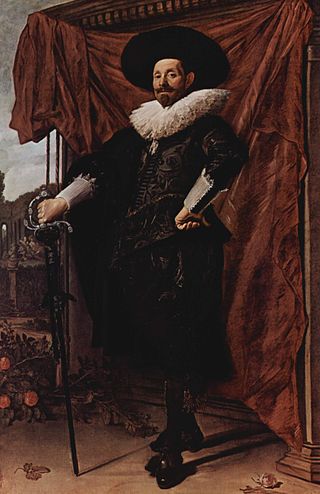
Willem van Heythuysen posing with a sword is an oil-on-canvas painting by the Dutch Golden Age painter Frans Hals, painted in 1625-1630, and now in the Alte Pinakothek, in Munich. It shows the Haarlem cloth merchant Willem van Heythuysen in a theatrical pose with a rapier.

Pieter Tjarck is a portrait painting by the Dutch Golden Age painter Frans Hals, painted in 1638 and now in the Los Angeles County Museum of Art, Los Angeles.

Marriage Portrait of Isaac Massa and Beatrix van der Laen is a painting by the Dutch Golden Age painter Frans Hals, painted c. 1622 and now in the Rijksmuseum, Amsterdam. The couple has been identified as Isaac Massa and his bride Beatrix van der Laen.
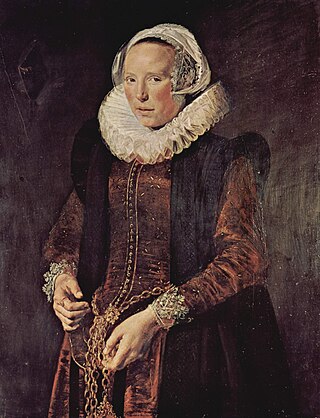
Portrait of a Woman Standing is a painting by the Dutch Golden Age painter Frans Hals, painted in 1610–1615 and now in Chatsworth House. It is considered a pendant portrait, but the sitter is unknown and therefore the pendant is not certain.

Catharina Both van der Eem is a painting by the Dutch Golden Age painter Frans Hals, painted in 1620 and now in Louvre Museum. It is considered a pendant portrait to the Portrait of Paulus van Beresteyn, in the same museum.
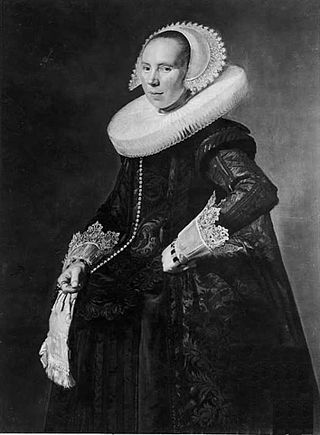
Portrait of Cunera van Baersdorp is an oil-on-panel painting by the Dutch Golden Age painter Frans Hals, painted in 1625 and now in a private collection. It is considered a pendant portrait to the Portrait of a Man Standing, now identified as Cunera's husband Michiel de Wael.

Portrait of Feyntje van Steenkiste is an oil-on-canvas painting by the Dutch Golden Age painter Frans Hals, painted around 1635 and now in the Rijksmuseum, in Amsterdam. It is considered a pendant to the portrait of Feyntje's husband Lucas de Clercq.

Portrait of Maria Pietersdochter Olycan is an oil-on-canvas painting by the Dutch Golden Age painter Frans Hals, painted in 1638, now in the São Paulo Museum of Art. It is considered a pendant to the portrait of Maria's husband Andries van Hoorn.

Portrait of Hylck Boner is an oil-on-canvas painting by the Dutch Golden Age painter Frans Hals, painted in 1635 and now in the Frick Collection. It is considered a pendant to the portrait of Hylck's husband Johannes Saeckma.
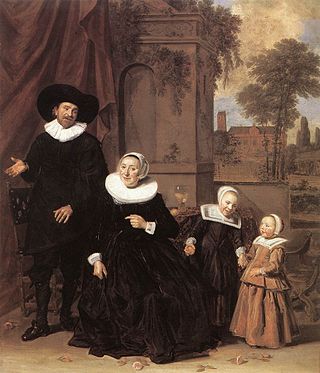
Portrait of a Dutch Family is an oil-on-canvas painting by the Dutch Golden Age painter Frans Hals, painted c. 1635 and now in the Cincinnati Art Museum, Cincinnati.

Family Group in a Landscape is an oil-on-canvas painting by the Dutch Golden Age painter Frans Hals, painted c. 1645-1648, and now in the Museo Thyssen-Bornemisza, in Madrid.

Portrait of Mrs. Bodolphe is an oil-on-canvas painting by the Dutch Golden Age painter Frans Hals, painted in 1643 as half of a pair of pendant marriage portraits and is still together with its pendant in the Yale University Art Gallery, New Haven, Connecticut.

Portrait of a Man is an oil-on-canvas painting by the Dutch Golden Age painter Frans Hals, painted c. 1660 and now in the Frick Collection, New York City. The man has been mistakenly identified as Michiel de Ruyter.

